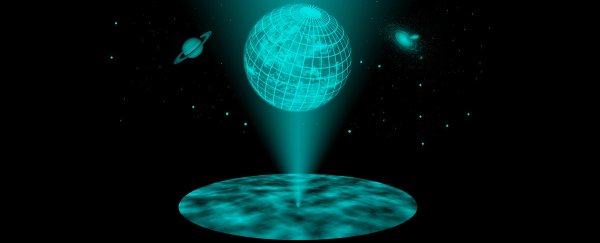As far as mind-melting ideas go, the 'hologram principle' is right up there. It predicts that, mathematically, the Universe requires just two dimensions, and only looks three dimensional to us because it acts like a giant hologram. It sounds pretty crazy, but over the past two decades, the principle has steadily been gathering steam, and now new results suggest that this principle holds true for flat spaces like our Universe, and could soon be tested.
This would mean that everything we see in our comfortable, three-dimensional world is just the image of two-dimensional processes, overlaid onto a huge cosmic horizon.
But let's back things up a little bit, because while this all sounds a little too whacky, the science actually holds up. The holographic principle was first proposed by physicist Leonard Susskind in the 1990s, and Jamie Lendino over at Extreme Tech does a great job of explaining the basic idea:
"It asserts that a volume of space can be thought of as encoded on a boundary to it - such as an observer-dependent gravitational horizon - and therefore needs one less dimension then it appears to need."
For this to be true, you would need to be able to map the results of gravitational phenomena - usually described with three spatial dimensions - onto the results of the behaviour of quantum particles - described with only two spatial dimensions.
Surprisingly, theoretical physicists found that this was indeed the case, and since 1997 more than 10,000 papers have been published supporting the idea.
But researchers had only ever studied this in negatively curved exotic spaces, which are very different to our own, flat spacetime Universe (you can get a background explainer on spacetime here).
What physicists mean when they say that the Universe is flat, is that space and time aren't being warped at all, and so our Universe can expand infinitely. If our Universe was positively curved, it would be a closed, spherical system, and anything you threw out into space would eventually return.
If it was negatively curved, "it would expand outwards forever, but with some bizarre effects - like two laser beams fired in parallel drifting away, or drawing triangles where the angles add up to less than the 180 degrees you're used too from school," astrophysicist Alan Duffy from Swinburne University of Technology in Australia, who wasn't involved with the research, told ScienceAlert.
Now the team from Vienna University of Technology (TU Wien) in Austria has taken things one step further and, publishing in the journal Physical Review Letters, has shown that the holographic principle could hold true even in a flat system, like our Universe.
"If quantum gravity in a flat space allows for a holographic description by a standard quantum theory, then there must by physical quantities, which can be calculated in both theories - and the results must agree," said lead author Daniel Grumiller in a press release.
To work this out, Grumiller and his team constructed gravitational theories that worked in our flat spacetime Universe, and didn't require an exotic, negatively-curved space. They then tested to see whether a key feature of quantum mechanics - quantum entanglement - appeared in these theories.
As Lendino explains for Extreme Tech: "It turns out you can measure the amount of entanglement in a quantum system, which is called the entropy of entanglement. Grumiller shows that it has the same value in flat quantum gravity and in a low-dimension quantum field theory."
"This calculation affirms our assumption that the holographic principle can also be realised in flat spaces. It is evidence for the validity of this correspondence in our Universe," said one of the researchers, Max Riegler, in the release.
And that result is kind of incredible and terrifying all at the same time, because it means we might soon be able to verify the idea that we're living in a giant hologram.
"The fact that we can even talk about quantum information and entropy of entanglement in a theory of gravity is astounding in itself, and would hardly have been imaginable only a few years back," said Grumiller. "That we are now able to use this as a tool to test the validity of the holographic principle, and that this test works out, is quite remarkable."
Update 29/4/2015: The article originally stated that both positively and negatively curved systems are closed systems. This was incorrect. Negatively curved systems can continue to expand indefinitely in a saddle-shaped system (read more here).
Source: Extreme Tech
